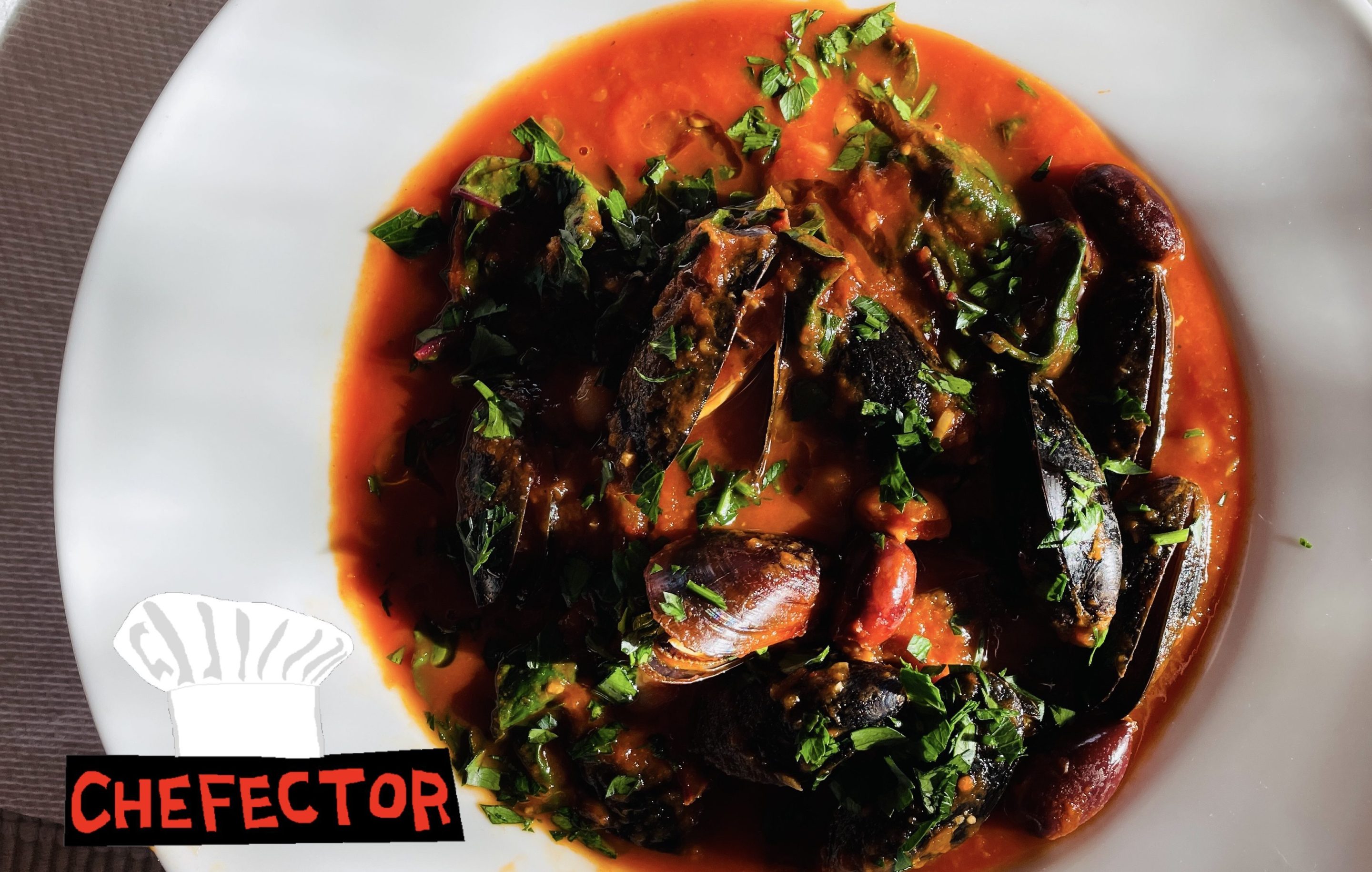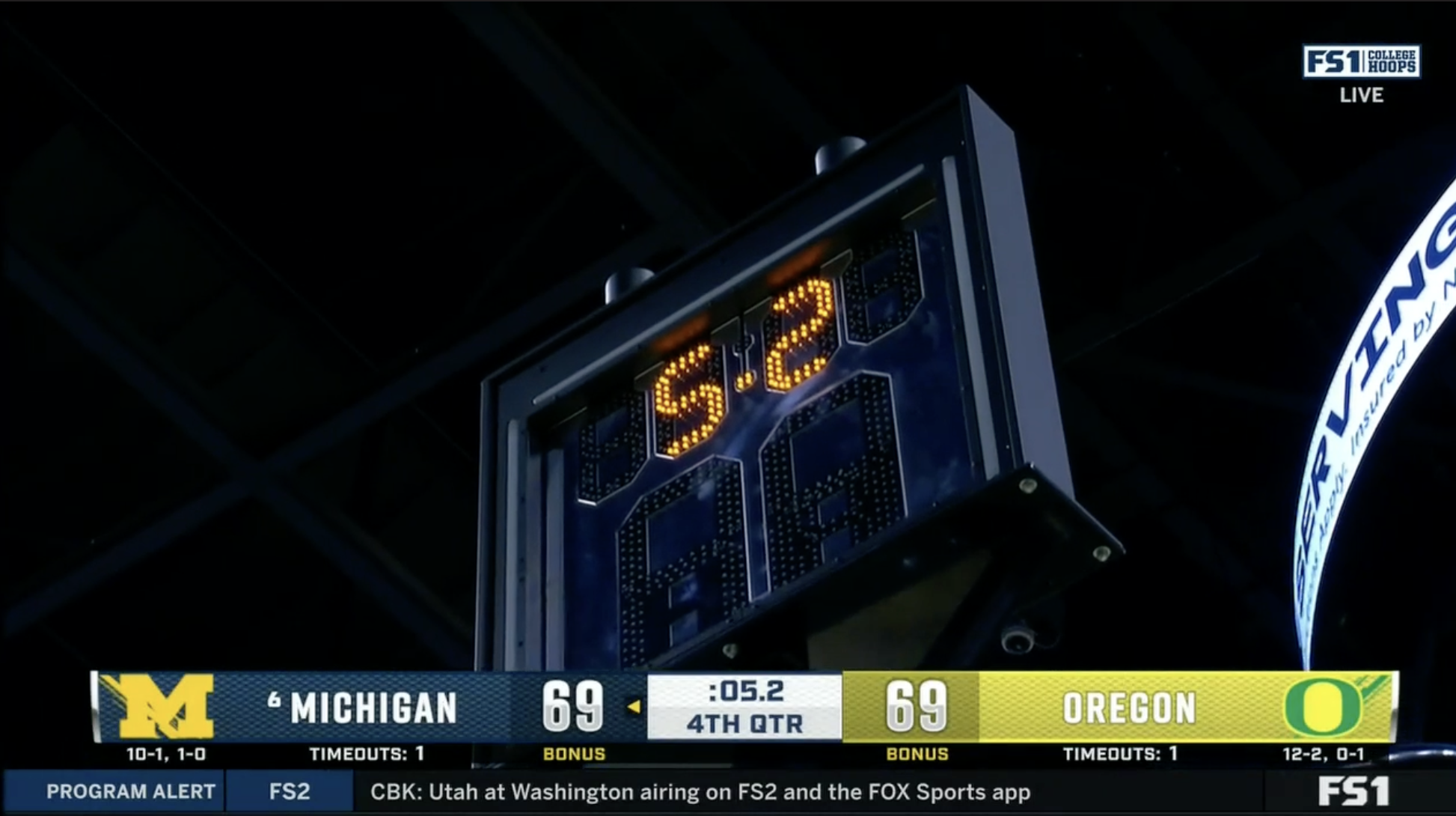Maybe you have had the experience of standing in front of a big exciting display case of fresh seafood, possessed by an intense but unspecific craving for some delicious fresh seafood but without any specific vision of what exactly you want to eat. Or maybe you have had the much more harrowing experience of having purchased some fresh seafood because of said craving, and now standing in your kitchen well aware of the invisible ticking countdown to when that seafood will go from being fresh (and perhaps even alive) and delicious to being, at best, slightly suspect, if not outright horrifying, and still without any specific vision of what exactly you are going to do with it.
I am here to tell you, my friends, that you can almost always just whip up some seafood stew out of the stuff you're likely to find in your kitchen. With few exceptions, this will come together quickly, because with few exceptions fresh seafood cooks quickly, so it's not an hours-long cooking project in the manner of other types of stew. And, I feel reasonably confident asserting, it will be delicious, because fresh seafood is delicious and assembling flattering flavors and textures around it is very nearly too easy to fuck up.
I will offer, as a helpful example of this, myself, and the impromptu stew I threw together a couple of weeks ago, when I had a bag of mussels and no plan for what to do with the mussels and an about an hour to go before what the people who depend on me to put dinner on the table would consider a normal dinnertime. I just kinda dug through the (admittedly somewhat overstuffed by pandemic anxiety) kitchen, looking for stuff that seemed like it might work, and wound up serving a perfectly cromulent and in fact outright delicious meal. I don't think it would have impressed, like, Jacques Pépin, but he can go to hell for all I care!
What I am saying here is, let's make some seafood stew. Let's just do it. Or anyway let's discuss how I did it.
Here is where, typically, you'd find a list of some things you need. We can do that; we'll get to it in a second. But the idea, here, is to work with what you already have. I'm gonna list some stuff I had, and which I turned, on short notice, into a tasty stew-like configuration, a hearty brothy food that I'm just going to go ahead and call stew; you can get the ingredients and replicate what I came up with (it really was quite tasty!), or you can, like, take inspiration from this venture and go spelunking through your kitchen and make a stew out of what you find. It doesn't matter much to me either way; if you do the latter and your stew sucks mondo butt, I will not be stuck eating any of it.
I'd bought a little net bag of mussels. Mussels are cheap, delicious, and fairly easy to work with, give or take however fussy you want to get about scrubbing and de-bearding them. The only real challenge they pose is that they're alive when you buy them, and will not remain so for very long; you can't buy them on Monday when you're shopping for the whole week, with the idea that, oh, what the hell, by Friday you'll have figured out some fun way to prepare them. If you buy them on Monday, you probably ought to plan on cooking them and eating them on Monday, or by Tuesday evening at the very latest. Otherwise you risk absolutely destroying a toilet on Wednesday. (Needless to say, when I bought the mussels, I did so without a plan for them.)
An important point, here, is that nothing about making this ultimately pretty delicious and extremely easy seafood stew required that seafood to be mussels. The cooking process might have been, oh, like three percent different if it had been, say, an equal quantity of littleneck clams, or a hunk of cod loin or haddock or rockfish, or a big double-fistful of peeled and deveined shrimp—or even, why not, lobster. Hell, I bet it would have been perfectly delightful if I'd been scrambling for a use for canned chopped clams. It would have kicked ass with squid, though the cooking process would have been very different. Mussels are what I had, and it was delicious with mussels. If you're going the mussels route, give them a rinse under cold water at the very least, if not a full debearding, and chuck any that are dead. If you're going some other route, I hope it takes you to hell!
I had a big yellow onion, and diced it; I had garlic, and minced it. I had a can of tomatoes, and a wee can of tomato paste. I had a jar of anchovy fillets, packed in oil. I had olive oil. I will always have these; odds are, you have some of them too, hidden behind an ancient bag of potatoes or buried beneath your extravagant hoard of novelty hot sauces. Naturally I had salt and black pepper; what kind of a monster do you take me for?
Then there's the stuff I do not always have, but happened to have. I had a bulb of fennel, which I sliced finely. As with the mussels, I got the fennel without any concrete plan for it; fennel is always fine shaved into a salad, or in ragù, or simmered into the broth you use to make risotto. Rooting around behind the absurd hoard of canned seafood, I found an eight-ounce bottle of clam juice. Jackpot! This stuff whips ass. I'd probably gotten it for some old risotto venture and forgotten all about it; I'd probably never even made the risotto; such is the life of a ruined ADHD brain.
Things seemed to be shaping up in a vaguely Mediterranean/southern European sort of way; that's just how a random trip through the recesses of my kitchen will go. Now it was time to pursue that emerging theme. I had dried oregano and smoked paprika and red pepper flakes in the insanely disorderly Spice Chaos consuming part my kitchen cabinet. Poking around through the fridge's voluminous selection of Stuff I Had Better Use Soon Or Throw Away, I found a little plastic tub of pitted Kalamata olives from the olive bar at the grocery store. Nice, nice. And, though I'm not sure it fit all that well with the theme, I had a big bunch of red chard, sort of uncomfortably crammed into the vegetable drawer, still fresh but not for much longer; I trimmed the leaves away from the fibrous stems, and sliced the leaves into more manageable size. (I bagged the stems and put them back in the fridge for some near-future use, and promptly forgot them.) I had some flat-leaf parsley.
Finally, this stuff, whatever it would be, would need some heft, something that would render it hearty and satisfying on top of being tasty. I did not have a loaf of crusty bread—drat—but I had a can of cannellini beans, another thing my kitchen pretty much always has in it. That pretty definitively swung this whole deal from "mussels in broth" over to "stew"; this had not been my original destination, but it's a nice and fine place to wind up.
I suppose in an ideal world I would have had some white wine with which to deglaze the pot, but I didn't. Alas. Maybe you have some white wine! If you have some white wine, you can choose to use some of the white wine. You can also choose not to use any of the white wine; you can choose to drink the white wine instead. You can choose to load up a Super Soaker with the white wine and ambush the dang neighbors with it! It's none of my business, and I don't give a damn! You can also decide, as I suspect some of you will suggest down in the comments, that you would want to chuck some cubed pancetta or some other form of salty pork into the early cooking stages of this. That's fine. The whole point here is for you to follow your tastes and ideas around the kitchen and grab whatever tickles them.
In any event, at some point I had to stop pulling my kitchen apart for ingredients. Then I turned all of this stuff into a frankly pretty tasty dinner. Here's how you can do that.
Haul out a nice big Dutch oven or saucepan or pasta pot or whatever, and heat it up over medium heat on the stove. When it's nice and hot but not yet melting, dump in a glug of olive oil, give it a few moments to heat up, and then chuck in the diced onion and sliced fennel. Sprinkle a pinch of salt over this stuff and kinda move it around every minute or so with your wooden spoon or silicone spatula or your driver's license duct-taped to the end of a chopstick or whatever. By the time 10 minutes have passed, the aromatics in the pot should be generally fragrant and softened; the fennel will lag behind the onion on their journey to true translucence, but that's OK. You can wait around another five or 10 or 15 minutes if you want genuinely soft, translucent onions and fennel—this will make them sweeter—or you can proceed.
Toss in a hearty pinch of the red pepper flakes and several—I'm watching you! It better be several and not one or two!—anchovy fillets. Move stuff around with your trusty implement. Within a minute or two the anchovy will have dissolved and the red pepper will have given an orange tint to the oil in the pot. Chuck the minced garlic in there and toss it around; within 30 seconds you should be able to smell it cooking, which means it's time to dump the tomato paste in there and fold and turn and mix everything together with your implement.
Move this stuff around every minute or so, but try to give it, oh, 10 minutes to cook. Ideally you will get some tomato paste sticking to the bottom of the pot and caramelizing; you'll deglaze it soon, and it will add depth of flavor to your finished product. Oh, hey, speaking of that: When the tomato paste's color has darkened and it smells deep red and sexy and there's a bit of it stuck to the bottom of the pot, pour the clam juice in there, all of it, and use your trusty implement to scrape the bottom of the pot. (If you decided to use some white wine, you can deglaze the pot with that instead, and add the clam liquid after.) The cooked-on stuff should loosen up and lift off pretty straightforwardly, unless you have ignored my previous instructions and used a wooden orange crate instead of a pot, fucking again, despite all my previous admonishments to quit doing this, in which case you have breached the sacred blogger-reader covenant for the very last time and must wander the outer dark alone for eternity as penance.
It's time to add the canned tomatoes. You can just dump them in there and break them up with your trusty implement! It's fine. You can also crush them one by one in your mighty fist and drop their ragged destroyed remains into the pot, if that is more your speed. Dump the liquid from the can into the pot, too. Stir everything around until it's all combined and let it come back up to a simmer. Grind some black pepper in there, and stir in a pinch each of the smoked paprika and dried oregano. Stir everything around again; taste it to see if it needs salt. It's probably fine to err on the side of less salt, for now, since later on you're going to add Kalamata olives to this sucker, and they're plenty briny. The pinch you added back at the beginning, when you were sweating the aromatics, may well have been plenty; if it wasn't, uh ... add some more.
That was it, for now. Once this stuff is simmering steadily, lower the heat a tad so it stays there, and plan on giving it, oh, a half an hour. This is not some all-day cooking project! All the same, its ingredients and flavors will benefit from some time to hang out together and exchange phone numbers.
After that half hour, you can make A Decision. If you have an immersion blender, you can blend this stuff into a smooth, velvety broth; that's what I did, and I recommend it. If you do not have an immersion blender, I guess you could let the stuff cool, and then blend very, very small batches of it one at a time in a regular standing blender (or, hell, a food processor maybe?). Or you can simply not blend it at all, and enjoy the nice chunkiness of your finished product. Or, I suppose you can not blend it, but just go on simmering it for a very long time until its solid matter has broken down and dissolved; I will not vouch for this approach, but I also promise not to call the police if you attempt it.
Whatever you did to it, so long as you did not pour it down the garbage disposal, it's time to finish cooking this stuff. Add the chard leaves to the pot, a handful at a time, and fold them into the stuff that's already in there. Do not worry if it seems like your normal-sized Dutch oven or pasta pot or whatever cannot possibly contain all these curly, fibrous leaves! This is chard; it wilts if you say something gently rude about its outfit. Within a couple of minutes of exposure to the hot liquid in the cooking vessel, it will have wilted down to a tiny fraction of its former size. Now, dump the olives and the (drained) cannellini beans in there and stir everything around. These just need to heat up, really; you're adding them now because it'll be harder and more impractical to stir or toss this stuff once it has a bunch of mussels in it.
Oh hey right: the mussels! Dump those dang mussels right on in there; while they're still closed, toss everything around gently with your implement of cooking. I guess I should have noted several paragraphs ago that you will need to do this in a pot that is large enough to A) fit all of the mussels under a snug-fitting lid, and also B) fit all of the mussels when they have opened due to cooking. Oh well! I hope you intuited that part! Clap a lid on that sucker, bump the heat up a tad to make up for how the temperature plummeted when you dumped a bunch of cold sea rocks into the pot, and wait, oh, five minutes. Five minutes may well turn out not to have been enough time, depending on the size and material of your pot and thus how well it retains heat; it's fine, after five minutes, to pop the lid open, poke around with your implement to see whether all or nearly all of the mussels have opened, and stick the lid right back on there for another five minutes if it seems as though they haven't. The mussels are not going to attain some awful inedible overcooked state in that time, I promise.
In any event, after some (hopefully minor) number of intervals, all or nearly all of the mussels will have cooked and opened up; any that haven't can be discarded. That was it. Serve this stuff in bowls via whatever method is convenient for you, whether it's ladling mussels and broth together, or plucking the mussels out and distributing them among bowls and then ladling broth over them. Drizzle some extra-virgin olive oil over each serving and sprinkle some chopped parsley on there, too. You're done! Eat!
Typically this is where you get a slightly (or not slightly) purplish description of what the food tastes like. But since the idea here is that you traipsed through your own kitchen, rounded up your own ingredients, and made your own dang seafood stew, I have no earthly idea what it tastes like. Maybe you used salmon instead of mussels! Maybe your kitchen furnished some whole other flavor profile, from some whole other part of the world. Maybe you ordered a pizza, like a real jerk.
My stew was rich and aromatic; between the anchovies, the clam juice, and the liquid released by the mussels as they cooked, it was suffused with a nice deep seafood flavor. The tomato and olive made it bright and vivid; the chard, as always, threatened to walk off with the show; the mussels were mussels and didn't strictly need any of this in order to be delicious but were flattered by the effort. After they were gone it was nice to spoon up the broth, though it would have been great to dredge some crusty bread through it. I'm confident yours will be delicious, and certain it will be yours. That's cool.







